🐾 Introduction
As cats age, their dietary needs change in ways that aren’t always obvious. What your cat needed at 3 years old is very different from what they need at 13. That’s why understanding senior cat nutrition is so important—it lays the foundation for a longer, healthier, and more comfortable life.
Looking for a full checklist on senior cat care? Don’t miss our Senior Cat Tips article for practical, everyday advice.
Table of Contents
- 1. Why Senior Cat Nutrition Matters
- 2. What Nutrients Do Senior Cats Need?
- 3. Wet vs. Dry Food: Which Is Better?
- 4. Monitoring Health Alongside Nutrition
- 5. Should You Add Supplements?
- 6. Create a Nutrition-Friendly Environment
- 7. Conclusion
🍽️ 1. Why Senior Cat Nutrition Matters
As our cats grow older, the changes can be subtle at first—a little less energy during playtime, a longer nap in the sun, or maybe a bit of hesitation before jumping onto the couch. These gentle shifts are all part of aging, and just like us, cats have evolving needs as they enter their senior years.
One of the most important—yet often overlooked—aspects of senior cat care is nutrition.
Older cats typically experience a slower metabolism, meaning they don’t burn calories as efficiently as they once did. Their activity levels decrease, and they may also become more sensitive to what they eat, with digestion that’s not quite as quick or easy as it used to be.
That’s why feeding your senior cat the same food they enjoyed in their younger years may no longer be the best choice.
A diet tailored to their age and health condition can make a world of difference. It can help:
- Maintain a healthy weight, which is critical in preventing strain on joints and organs
- Support joint and organ function, especially kidneys and liver, which become more vulnerable with age
- Prevent or manage age-related conditions, like diabetes, dental issues, or early-stage kidney disease
We’ve seen firsthand how even modest changes in diet—switching to a senior-specific formula, adjusting portion sizes, or adding a supplement—can lead to noticeable improvements in mood, mobility, and overall well-being.
It’s not about being perfect or feeding the most expensive brand—it’s about tuning into what your cat needs right now and making small, loving changes that truly support them.
And remember, every senior cat is unique. What works for one may not work for another. But with a little observation and care, you’ll start to see what brings your cat the most comfort and health in this gentle chapter of life.
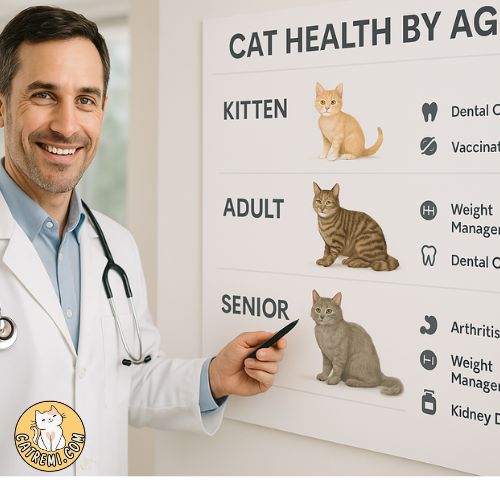
🥩 2. What Nutrients Do Senior Cats Need?
Feeding a senior cat is a bit like preparing a meal for someone you love who’s grown a little older and a little more delicate—there’s thought, care, and gentle attention in every scoop.
As cats age, their bodies change inside and out. They may not show it with loud complaints, but their needs are quietly evolving. The good news is, with the right nutrition, we can support them through this stage of life and help them feel as comfortable, active, and well as possible.
When choosing food for your senior cat, here are some key nutrients to look out for:
🐟 High-Quality Protein
Senior cats still need protein—but it has to be the right kind. High-quality, easily digestible protein helps maintain muscle mass, especially as activity levels drop. Muscle loss is common in older cats, and supporting lean body mass can improve their mobility and strength.
🧈 Lower Fat & Calories
Since senior cats tend to move less, they don’t burn as much energy as they once did. That means lower calorie food is often a better choice to prevent unwanted weight gain, which can lead to diabetes or worsen joint issues. But remember—not too little fat, as they still need energy and flavor to stay interested in their meals.
🧠 Omega-3 Fatty Acids
Often found in fish oil, omega-3s are like a daily hug for your cat’s joints, skin, and brain. These healthy fats support cognitive function, reduce inflammation, and can even bring a little shine back to a dull coat.
❤️ Taurine
An essential amino acid for cats, taurine plays a key role in maintaining heart and vision health. Senior cat foods usually include added taurine, but it’s always worth checking the label to make sure.
🦴 Glucosamine & Chondroitin
If your cat is moving a little slower or hesitating before jumping, their joints might need some extra support. These two nutrients are known to help protect cartilage and improve joint mobility, making everyday movements more comfortable.
🌾 Fiber & Prebiotics
A gentle digestive system needs extra help sometimes. Fiber and prebiotics keep things moving smoothly and support a healthy gut microbiome, especially important if your cat is prone to constipation or has a sensitive stomach.
We’ve found that once we started paying attention to these nutrients—not just the brand name or the packaging—our cat became more energetic, more alert, and more herself again. Every senior cat is different, but they all deserve nutrition that truly nourishes.
Sometimes, it’s not just what’s in the bowl—but the love and care behind choosing it—that makes the biggest difference.
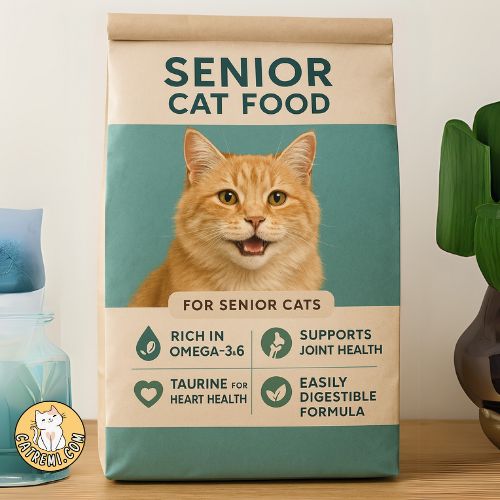
🥣 3. Wet vs. Dry Food: Which Is Better?
When it comes to feeding a senior cat, one of the most common questions we hear—and have asked ourselves—is:
Should I feed my cat wet food, dry food, or both?
The truth is, there’s no single right answer. Just like people, every cat has their own preferences, sensitivities, and health needs. What works beautifully for one senior cat might not work for another—and that’s okay.
That’s why choosing between wet and dry food is less about “what’s best” in general, and more about what’s best for your cat right now.
🐟 Wet Food: Gentle, Moist, and Easy to Eat
Wet food tends to be a favorite among older cats, especially those with:
- Dental issues, missing teeth, or sore gums
- Lower water intake from their bowl
- Slower digestion or sensitive stomachs
Because of its moisture content, wet food can help with hydration, which is especially important for cats prone to kidney or urinary issues. It’s also softer and easier to chew—something we noticed really mattered once our cat’s teeth weren’t what they used to be.
Some cats simply find it more appealing too. If your senior cat has become a picky eater, offering a warm, aromatic wet meal might just do the trick.
🥣 Dry Food: Convenient, Crunchy, and Long-Lasting
Dry food, or kibble, has its own set of benefits:
- Easy to store and serve
- May help reduce tartar buildup (though not a substitute for dental care)
- Useful for free-feeding or food puzzles
Some senior cats still love the crunch and texture, and it’s often more cost-effective. That said, if your cat has trouble chewing or drinks very little water, dry food alone may not be ideal.
🐾 What We’ve Learned: Sometimes, the Best Answer Is “Both”
In our home, we’ve found that a mixed approach works best. Wet food in the morning and dry food in the evening—or vice versa—gives variety, texture, and flexibility. We’ve also used wet food to hide supplements or medications, which helps avoid stress for everyone.
Above all, we listen to our cat. She tells us what works through her appetite, energy levels, and even her attitude after a meal.
So if you’re unsure where to start, try both. Watch. Adjust. And don’t be afraid to change things up as your cat’s needs evolve.
Because in the end, feeding your senior cat isn’t just about nutrition—it’s about nurturing, every single day.
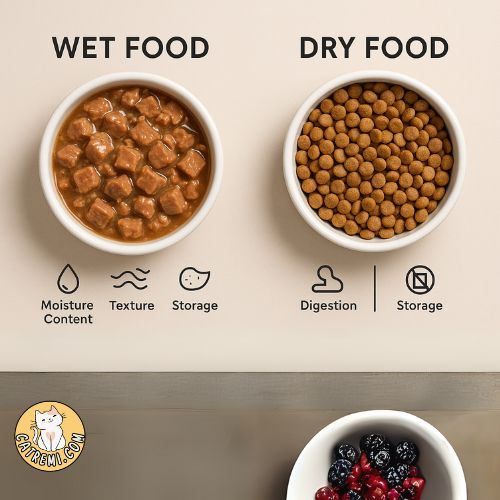
🧪 4. Monitoring Health Alongside Nutrition
Feeding your senior cat well is a beautiful act of love—but it’s just one piece of the puzzle. Just as important as what goes into their bowl is how they’re doing overall—physically, emotionally, and day by day.
Over time, we’ve learned that small changes in our cat’s behavior often say more than words ever could (if only they could talk!). That’s why paying attention to their daily patterns is so valuable. It helps us catch early signs of discomfort or illness—and gives us a chance to act before things become serious.
Here are a few gentle signals we now watch for regularly:
⚖️ Weight Changes
Has your cat lost or gained weight without any changes in diet? Weight loss could indicate issues like thyroid imbalance or kidney disease, while weight gain might signal slowed metabolism or overfeeding. A monthly weigh-in at home (or even feeling along their ribs and spine) can offer helpful clues.
🍽️ Appetite & Eating Habits
Is your cat still excited at mealtime? Do they leave more food in the bowl than usual? Sudden disinterest in food, chewing on one side only, or eating slower than normal could point to dental pain or digestive upset. On the other hand, an increased appetite might hint at thyroid or metabolic concerns.
🚽 Litter Box Behavior
Litter box habits are often the first place we notice something’s off. Increased urination could point to kidney problems or diabetes, while straining, constipation, or going outside the box may suggest discomfort or stress. Even changes in the way they bury or how often they visit can tell us something.
🧼 Coat Quality and Grooming
A healthy cat usually keeps their fur sleek and tidy. But if your senior cat stops grooming—or their coat becomes dull, greasy, or matted—it could be a sign of pain, arthritis, or even depression. Sometimes, they just need a little help from us with a gentle brush and some quiet company.
📝 Tip From Our Experience:
We started keeping a simple health journal—just a few lines each day or week about what we noticed. Over time, this helped us spot patterns and feel more confident when we visited the vet. It became a small habit with a big impact.
Caring for a senior cat doesn’t mean waiting for something to go wrong—it means noticing the quiet whispers before they become cries. And when we truly tune in, we find ourselves more connected, more present, and more able to give them the love they’ve always given us.
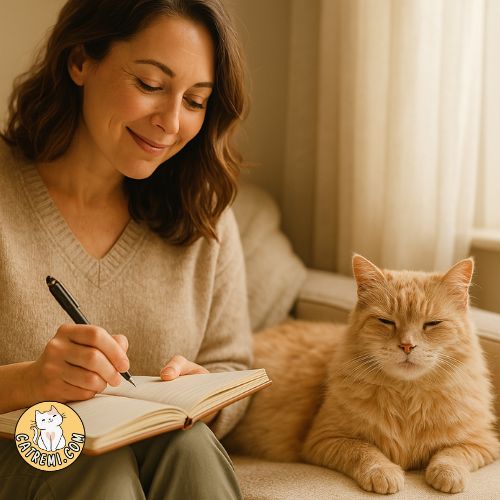
💊 5. Should You Add Supplements?
Even with the best-quality food in their bowl, there are times when our senior cats may need a little extra support—just like we humans sometimes reach for vitamins, joint support, or digestive aids as we get older.
The truth is, no two senior cats are exactly the same. Some seem to sail through their golden years with just a balanced diet and cozy bed. Others may start to show signs of stiffness, digestive troubles, or lower energy, even with great food and loving care.
That’s where supplements can play a gentle, helpful role.
Here are a few commonly used additions that we’ve seen make a real difference—always introduced slowly, and always under the guidance of a trusted vet:
🐟 Fish Oil
Rich in omega-3 fatty acids, fish oil supports:
- Joint health (reducing inflammation and stiffness)
- Skin & coat health (reducing dryness and itching)
- Cognitive function, especially in older cats
In our case, just a small daily dose added to wet food noticeably improved our cat’s flexibility and helped her fur regain that soft shine we’d missed.
🌿 Probiotics
As cats age, their digestive systems can become more sensitive.
Probiotics help maintain a healthy balance of gut bacteria, which:
- Improves digestion
- Reduces bloating or loose stools
- Strengthens immune response
Some senior cat foods already include them, but additional support can be useful after antibiotics or during stress.
🦴 Joint Chews (Glucosamine & Chondroitin)
For cats with arthritis or mobility issues, joint chews can be a game changer.
They:
- Lubricate joints
- Support cartilage
- Help maintain comfort during movement
Some come in soft chew forms with flavors cats enjoy—and we’ve found that giving one before bedtime became a moment of connection for us, too.
🌈 Multivitamins
These are gentle, general boosters that can help fill in nutritional gaps—especially useful if your cat eats less than usual or has special dietary needs. Look for formulas designed specifically for senior cats.
🙏 A Gentle Reminder:
Before starting any supplement, always speak with your veterinarian.
Even natural products can interact with medications or existing conditions, and your vet knows your cat’s unique story best.
In our experience, supplements aren’t a magic fix—but they can be a beautiful way to add just a bit more comfort, vitality, or sparkle to your cat’s life.
Sometimes, that little “extra” becomes part of a bigger feeling of peace—for them, and for us.
Because in caring for a senior cat, it’s never just about adding years to their life…
It’s about adding life to their years.
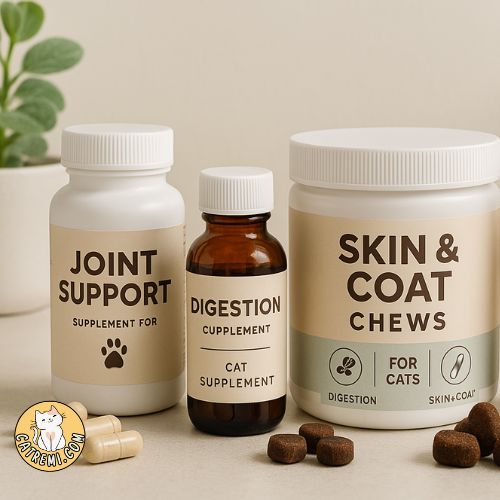
🛏️ 6. Create a Nutrition-Friendly Environment
When we think about feeding our senior cats, it’s natural to focus on what goes into their bowl. But equally important—especially as they age—is how and where they eat.
Older cats often move more slowly, have stiff joints, or feel more vulnerable than they used to. That’s why creating a calm, comfortable space around mealtimes can make a surprisingly big difference in their appetite, digestion, and overall well-being.
Think of it as not just feeding—but nourishing, in the fullest sense of the word.
Here are a few simple but thoughtful ways to make your cat’s eating environment more supportive as they grow older:
🍽️ Elevated Bowls to Reduce Neck Strain
As cats age, arthritis and muscle weakness can make bending down uncomfortable.
Raised food and water bowls allow your cat to eat and drink with a straighter neck and spine, which can:
- Ease joint pressure
- Improve digestion
- Make meals feel more natural and relaxed
We noticed our senior cat ate more calmly (and spilled less!) after we made this switch.
💧 Fresh Water in Multiple Locations
Senior cats are often more prone to dehydration, especially if they have kidney or urinary issues.
Placing multiple water bowls around your home encourages drinking without forcing your cat to travel far.
Bonus tip: Try a pet water fountain—many cats are drawn to flowing water, and it can gently increase their daily intake.
🤫 Quiet, Stress-Free Feeding Space
Just like us, cats appreciate peace and quiet during meals.
Place their food bowl in a low-traffic, cozy area, away from loud appliances or sudden movement. This helps reduce anxiety and lets them focus on their food without feeling threatened or distracted.
Especially in multi-cat homes, giving your senior cat a private feeding spot can also prevent food guarding or rushing.
🛏️ Soft Bedding Nearby for Post-Meal Rest
After a satisfying meal, most senior cats love a good nap.
Placing a plush blanket or orthopedic bed near their feeding area gives them a soft landing spot to relax and digest comfortably.
For our own cat, this turned into a little ritual—eat, stretch, then curl up with a sigh of contentment. It became a moment of comfort for her, and for us too.
In the end, it’s not just the nutrition in the bowl that matters.
It’s the quiet space, the thoughtful placement, the warmth we build into their routine that tells them: “You’re safe. You’re loved. This moment is just for you.”
And often, that environment we create with our hands becomes the comfort they carry in their hearts.
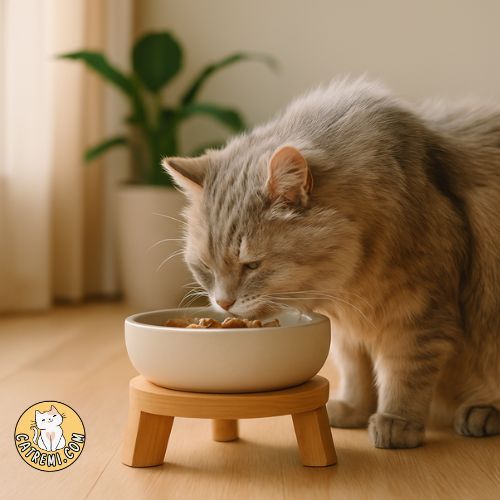
🐾 Conclusion
Caring for your cat in their later years is a journey filled with tenderness, patience, and quiet observation. At the heart of it all lies something simple, yet deeply impactful—senior cat nutrition.
When we take the time to understand how our cat’s needs have changed with age, and respond with gentle adjustments in their diet and environment, we’re doing more than just “feeding” them. We’re giving them the tools to stay comfortable, energetic, and emotionally connected in the years they have left.
It doesn’t have to be overwhelming. Often, it’s the small choices that make the biggest difference:
- Switching to a formula designed for senior cats
- Offering a quiet, cozy place to eat and rest
- Paying attention to subtle health signals
- Or even just adding a splash of warmth into their routine
What matters most is that we’re present—that we’re willing to keep learning, adjusting, and loving them in ways that truly support their changing bodies and spirits.
Because senior cat nutrition isn’t just about food—it’s about quality of life. It’s about helping your cat feel good in their body, secure in their space, and cherished every single day.
If you’re ready to continue this journey with even more love and knowledge, we invite you to explore our full guide on gentle, everyday care:
👉 Senior Cat Tips
Thank you for being the kind of cat parent who cares this deeply. Your senior cat may not say it out loud—but they feel it, in every moment you choose love over convenience, and presence over routine.
Learn more about feline nutrition from the
